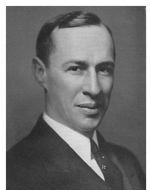The Theorists – Rensis Likert
There are a number of individuals who throughout the history and emergence of Organization Development have made a significant contribution to both the academic theory and practice of the field of OD.
Rensis Likert in Brief
Likert maintained throughout his life an energetic appreciation of Engineering, sociology, psychology, ethics, and statistics concepts. Curiosity about how things worked and how to fix them when they did not coupled with an innate talent for structures and measurements revealed themselves in his quantitative and pragmatic approaches to social problems and social measurements.
During the course of his doctoral research, he developed what soon became the famous Likert scale which has been adopted throughout the world,
Likert started the University of Michigan Institute for Social Research (ISR), the world’s largest academic social science survey and research organization. ISR developed and published many innovations in statistical methods and applications. These included scientific probability methods of sampling from the country level on down to the household and personal levels, sound methods of controls for responses and nonresponses, improved questionnaire and coding methods, machine computations, and deeper methods of analysis and presentation of results. For 60 years, social scientists have trained there to develop new research methodology.
Likert’s principal research interests and his collaborative efforts with many researchers, especially Robert Kahn, Daniel Katz, Floyd Mann, and Stanley Seashore developed in the area of participative management. The central principles of his System 4 are;
- Supportive relationships between organizational members;
- Multiple overlapping structures, with groups consisting of superiors and their subordinates;
- Group problem solving by consensus within groups
- Overlapping memberships between groups by members who serve as “linking pins.
Rensis Likert – Life and Times
- 1903 – Likert was born in Cheyenne, Wyoming
- 1922 – Likert entered the University of Michigan, concentrating on civil engineering until he took a course in sociology.
- 1926 – Transferred in his senior year from the college of engineering and took his bachelor’s degree in sociology
- 1932 – Took PhD at Columbia University Department of Psychology, moving from traditional fields of psychology to the new social psychology.
- 1938 – The Likert Scale appears in publication Public Opinion and the Individual
- 1939 – Appointed Director of U.S. Department of Agriculture’s Division of Program Surveys
- 1941 – Scope of Likert’s division expands to a general sample survey organization
- 1946 – Receives the Medal of Freedom for his leadership of strategic bombing surveys, leaves Washington to set up the Survey Research Center at the University of Michigan
- 1953 – Became Vice President of the American Statistical Association
- 1955 – Became President of the ASA
- 1961 – Published New Patterns of Management
- 1967 – Published The Human Organization: Its Management and Value
- 1976 – Published New Ways of Managing conflict
- 1970 – Retired from University of Michigan and set up Rensis Likert Associates
Key Contributions
- Likert Scale
- System 4 – Participative Management Principles
- Social Science Research Methods
- Organizational Survey
- Change Theories
Likert’s goal was to make the world better. His initiative, enterprise, and unending energies was backed by a youthful belief that the sciences of human behaviour could be developed to make unique and vital contributions to that goal.

